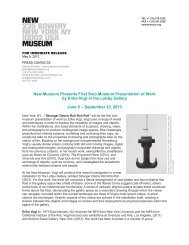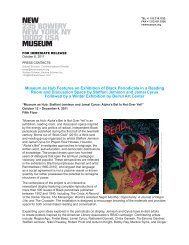The Body is a Machine
The Body is a Machine
The Body is a Machine
You also want an ePaper? Increase the reach of your titles
YUMPU automatically turns print PDFs into web optimized ePapers that Google loves.
From a contemporary perspective, the d<strong>is</strong>tance between<br />
our machines and our selves has never been closer. It <strong>is</strong><br />
an obvious and unavoidable fact that the expansive reach<br />
of new technology has had a profound effect on individual<br />
experience and social relationships. As much as our current<br />
wired state <strong>is</strong> the result of a constant stream of research and<br />
innovation, it can also be seen as the product of centuries’<br />
worth of dreams and nightmares—all env<strong>is</strong>ioning the ways in<br />
which machines can replace, enhance, or communicate with<br />
our bodies and minds. While developing technology continues<br />
to fascinate many contemporary art<strong>is</strong>ts, others mine the<br />
h<strong>is</strong>tory and mythology of machines, and the ways in which<br />
they have altered our world. If some of our productive and<br />
communicative functions have been or are in the process<br />
of being replaced by previously unimagined devices, then it<br />
stands to reason that these devices also start to become a<br />
part of our h<strong>is</strong>torical narratives. All of the art<strong>is</strong>ts in “Ghosts<br />
in the <strong>Machine</strong>” explore and, in many cases, advance the<br />
genealogy of human and machine interaction. <strong>The</strong> following <strong>is</strong><br />
in no way a complete chronology of how th<strong>is</strong> symbiotic relationship<br />
has developed, but instead assembles some notable<br />
protagon<strong>is</strong>ts (human and machine) that have led us to our<br />
current h<strong>is</strong>torical moment.<br />
<strong>The</strong> impulse to create a mechanical being that can mimic<br />
the actions and functions of humans long predates the modern<br />
period. <strong>The</strong>re are accounts of robotic humans or animals<br />
programmed to perform a variety of functions in the myths of<br />
a number of different ancient cultures. In <strong>The</strong> Writer (2007),<br />
Philippe Parreno films one of the most famous automatons<br />
of the early modern period—a life-size mechanical child,<br />
who has lost little of h<strong>is</strong> haunting personality. Originally built<br />
in the eighteenth century by Pierre Jaquet-Droz, the small<br />
figure was part of a trio built to replicate specific actions<br />
(writing, drawing, and playing music) and presented in public<br />
performances across Europe. In the film, the automated boy<br />
turns h<strong>is</strong> gears into action, lifts h<strong>is</strong> stylus, and slowly and<br />
deliberately spells out an enigmatic phrase programmed by<br />
Parreno: “What do you believe your eyes or my words?”<br />
Jaquet-Droz’s creations were a source of fascination for the<br />
French Surreal<strong>is</strong>ts whose subsequent technique of automatic<br />
drawing enacted their own desire for a mechanical life, functioning<br />
as a receiver of signals rather than a conscious creator.<br />
“Th<strong>is</strong> man-machine [that] has infinite consciousness or<br />
no consciousness,” 1 as Parreno says of Jaquet-Droz’s writer,<br />
continues to capture our imagination—not only because of<br />
the complexity of its internal mechan<strong>is</strong>ms and the uncanny<br />
quality of its actions, but also because it suggests the kind of<br />
universal thinking-machine eventually realized in the form of<br />
the computer.<br />
In the early twentieth century, a German doctor named<br />
Fritz Kahn produced a number of brilliant and startling v<strong>is</strong>ualizations<br />
that detailed the way in which bodily functions were<br />
equivalent to forms of industrial, mechanical, and electronic<br />
activity. Kahn did not propose to replace human functions<br />
with technology; instead, he sought to point out the complex<br />
machinery that was already at work inside us all. In one of<br />
h<strong>is</strong> many illustrated pamphlets he wrote: “<strong>The</strong> true miracle<br />
lies in the fact that the human body <strong>is</strong> not only the most<br />
high-performance and robust machine, but also the finest<br />
and most complicated of all machines.” 2 H<strong>is</strong> most famous<br />
drawing, Der Mensch als Industriepalast [Man as Industrial<br />
Palace] (1926), imagines the human body populated by a<br />
team of scient<strong>is</strong>ts, engineers, and laborers, operating a network<br />
of chemical plants, plumbing systems, and research labs.<br />
Kahn uses these technological systems as explanations for<br />
15<br />
the otherw<strong>is</strong>e mysterious operations of our bodies. During<br />
the interwar period, in which Kahn was working, nascent<br />
technology became the greatest threat to the fragile human<br />
body. By employing industrial metaphors for the body, Kahn<br />
made th<strong>is</strong> technology both immediately understandable and<br />
strangely comforting.<br />
<strong>The</strong> concept of the body as a machine was advanced<br />
both theoretically and practically in the work and writings of<br />
Brit<strong>is</strong>h mathematician Alan Turing. Turing’s work during the<br />
1930s and ’40s laid the groundwork for the development of<br />
the computer (by postwar scient<strong>is</strong>ts, mathematicians, and<br />
engineers) and its increasing ability to replicate human actions<br />
and thoughts. “Some Illustrations on the Life of Alan Turing”<br />
(2008) <strong>is</strong> a series of thirty collages by the Dan<strong>is</strong>h art<strong>is</strong>t Henrik<br />
Olesen documenting the life of the influential mathematician<br />
from childhood until h<strong>is</strong> suicide at the age of forty-one. In<br />
1936, he proposed the concept of the Turing <strong>Machine</strong>, which<br />
Olesen describes as “a virtual system, capable of simulating<br />
the behavior of any other machine, even, and including itself.”<br />
Olesen’s series addresses both Turing’s immense contribution<br />
to digital technology and the more tragic side of h<strong>is</strong> story.<br />
After being identified as a homosexual, Turing was arrested<br />
and forced to undergo a variety of treatments in order to<br />
allegedly cure what were believed to be deviant and uncontrollable<br />
impulses. <strong>The</strong>se treatments, which included Reichian<br />
Orgone therapy and the admin<strong>is</strong>tration of female hormones,<br />
were an attack on the legitimacy and autonomy of Turing’s<br />
body and likely contributed to h<strong>is</strong> depression and eventual<br />
suicide. Beyond the realm of theoretical mathematics, the<br />
Turing <strong>Machine</strong> offered the possibility of replacing one’s<br />
body with a machine—fulfilling any desire for emotional<br />
detachment, extended life, and physical as well as intellectual<br />
reinvention.<br />
In the late 1960s, the art<strong>is</strong>t Channa Horwitz began creating<br />
a conceptually rigorous body of work that provides<br />
another kind of blueprint for mechanizing the human body.<br />
In 1968, Horwitz began her “Sonakinatography” works, a<br />
series of meticulously detailed ink drawings on graph paper.<br />
Although the variegated appearance of the drawings offers<br />
a sat<strong>is</strong>fying optical pattern, the repetitive marks within them<br />
are actually a complex system of notations which cons<strong>is</strong>t<br />
of a sequence of eight colors that represent durations of<br />
time while the graph-like patterns indicate forms of motion.<br />
<strong>The</strong> end results are works that can be viewed as scores to<br />
be read or, better still, programs to be enacted in a variety<br />
of media. In 2012, a group of eight men and women performed<br />
Poem/Opera, <strong>The</strong> Divided Person, an interpretation<br />
of Horwitz’s Sonakinatography Composition III, in New York<br />
City’s High Line park. Dressed in black, the performers each<br />
recited a sequence of descriptive adjectives plotted across a<br />
twenty-five-foot-long scroll. Through its prec<strong>is</strong>e rhythm and<br />
d<strong>is</strong>passionate phrasing, the nearly hour-long performance<br />
resembled a vintage piece of software being executed by a<br />
linked network of human computers. As in much of Horwitz’s<br />
work, the infinite ways in which her drawings can be transformed<br />
and expressed bridge the gap between organic bodies<br />
and mechanical expressions.<br />
Another drawing by Horwitz documents her proposal<br />
for the “Art and Technology” program at the Los Angeles<br />
County Museum of Art in 1968. Curator Maurice Tuchman<br />
sought to pair art<strong>is</strong>ts, writers, and musicians with corporations<br />
in a variety of fields, granting creative individuals access to<br />
advanced scientific research and industrial facilities in order<br />
to produce innovative new works of art. Horwitz proposed<br />
an optical and kinetic sculpture using forces of magnet<strong>is</strong>m or




